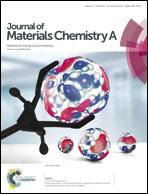Cu2O nanorods modified by reduced graphene oxide for NH3 sensing at room temperature†
Abstract
In this work, Cu2O nanorods modified by reduced graphene oxide (rGO) were produced via a two-step synthesis method. CuO rods were firstly prepared in graphene oxide (GO) solution using cetyltrimethyl ammonium bromide (CTAB) as a soft template by the microwave-assisted hydrothermal method, accompanied with the reduction of GO. The complexes were subsequently annealed and Cu2O nanorods/rGO composites were obtained. The as-prepared composites were evaluated using various characterization methods, and were utilized as sensing materials. The room-temperature NH3 sensing properties of a sensor based on the Cu2O nanorods/rGO composites were systematically investigated. The sensor exhibited an excellent sensitivity and linear response toward NH3 at room temperature. Furthermore, the sensor could be easily recovered to its initial state in a short time after exposure to fresh air. The sensor also showed excellent repeatability and selectivity to NH3. The remarkably enhanced NH3-sensing performances could be attributed to the improved conductivity, catalytic activity for the oxygen reduction reaction and increased gas adsorption in the unique hybrid composites. Such composites showed great potential for manufacturing a new generation of low-power and portable ammonia sensors.


 Please wait while we load your content...
Please wait while we load your content...